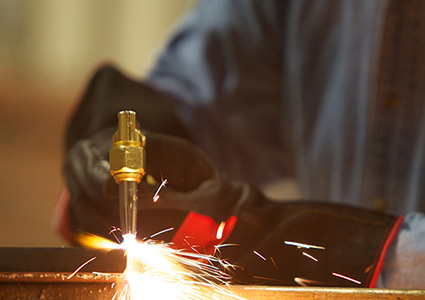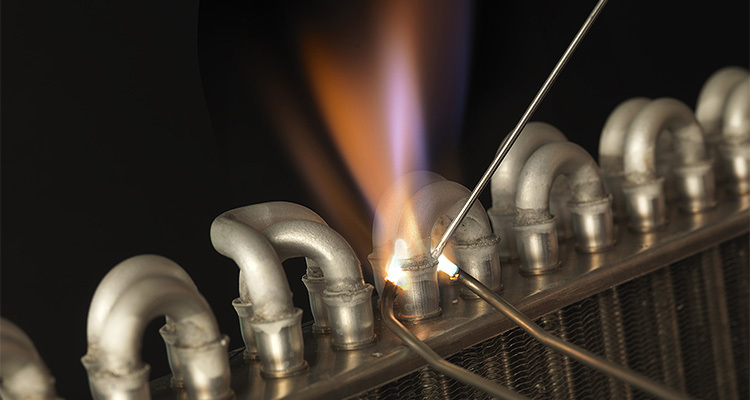How The Harris Products Group continues to create the right products to meet customer demand
Beginning in 1899, John Harris discovered the oxy-acetylene method of cutting while conducting research on the manufacture of synthetic rubies. While working on the materials, he accidentally cut the metal plate beneath the synthetic ruby, discovering the world’s first flame-cutting torch. He exhibited the torch at the 1904 St. Louis World’s Fair and started Harris Calorific in 1905.
Meanwhile, in 1914, Joseph W. Harris founded the J.W. Harris Company, specializing in the distribution and repair of specialized parts for automotive and farm vehicles. The company later expanded into welding alloys and accessories.
Recognizing the complementary products that Harris Calorific and J.W. Harris had to offer, Lincoln Electric acquired both companies, and The Harris Products Group (HPG) was formed in 2006. Today, as a segment of Lincoln Electric, HPG is a world leader in metal working products used in the brazing, soldering, cutting, and gas distribution industries. Since its formation, additional companies have strengthened the company’s portfolio, with HPG currently operating 11 manufacturing facilities in six countries.
 Gregory (Greg) Doria, Senior Vice President and President of The Harris Products Group, joins Manufacturing Today to share the organization’s story. “The business today is comprised of everything to do with brazing and gas equipment,” he begins. “We have several manufacturing facilities around the world, and we’ve separated the business into gas control equipment and brazing and fabricated parts, which includes consumables, as well as component parts that require brazing to create the finished goods.
Gregory (Greg) Doria, Senior Vice President and President of The Harris Products Group, joins Manufacturing Today to share the organization’s story. “The business today is comprised of everything to do with brazing and gas equipment,” he begins. “We have several manufacturing facilities around the world, and we’ve separated the business into gas control equipment and brazing and fabricated parts, which includes consumables, as well as component parts that require brazing to create the finished goods.
“Our facility in Gainesville, Georgia, just outside of Atlanta is a primary site for gas control equipment. We also have a facility in Dzierżoniów, Poland, where we manufacture gas torches and cutting apparatus, as well as gas control equipment. Our plant in Verona, Italy, focuses on engineering and design from a manufacturing standpoint, and also manufactures a valve integrated pressure regulator, known in the industry as a VIPR. While these are very common around the world, and improve safety and productivity, they’re relatively new in the US market, so we’ve seen considerable growth in the last five years or so as this product has been introduced to the US.
“We’ve found overall efficiency by focusing on the strength of each of our plants and using those strengths to bolster each segment. In some instances, for example, it can be more efficient to approach production by splitting processes between sites,” he elaborates.
“I’m based in Mason, Ohio, where we have a full casting operation to make finished brazing rods. We also have locations in Brazil and Portugal that do similar outputs for local markets, other than for the European market, which has a high silver component to it as well.
“Our plants focus on unique capabilities and service the local markets, remaining close to customers to better service their needs. Our site in Brazil, for instance, does a little bit of everything, primarily for the Latin American market. Having an extensive global footprint really gives us a strong advantage in terms of being flexible and quick to respond to our customers’ requirements,” Greg explains.
Alongside this local presence, investments in automation have also been critical to improving productivity and meeting demand. “Post Covid, we found that our customers were faced with numerous supply chain challenges and couldn’t get the products they needed,” Greg recalls. “We responded by installing and implementing automation to be able to supply those customers. Being part of Lincoln Electric, which has a nearly billion-dollar automation company in its portfolio, gives us a key advantage in that we can work internally to automate our own facilities. At Lincoln Electric, we can be at the forefront of advanced manufacturing. Thanks to our automation expertise, we are at the point where we’re able to manufacture many of our regulator models almost lights-out in terms of inputting the components and then receiving a finished product from a conveyor belt. Lincoln Electric recently acquired Fori Automation, a manufacturer of automated guided vehicles (AGVs), so we’re currently evaluating how we can further automate the flow of material in our own operations.
“Likewise, having robust relationships and mutually beneficial partnerships with our suppliers is critical to operational success and has positioned us well over the years, particularly during turbulent times. Having a strong internal team that focuses on supplier relationships helps to improve partnerships from a reciprocal perspective.”
Under Greg’s leadership, HPG is focused on anticipating demand and serving customers in new growth areas. To achieve this goal, it’s essential to have the right skill set in place. “One of our guiding principles since our founding is to treat others as we would like to be treated,” he states. “We strive to shape the right environment and culture; one that demonstrates that we care about our employees’ wellbeing and what’s important to them. People’s priorities have changed post-pandemic, so we need to create an environment in which our skilled people can thrive.
“Likewise, another key objective that runs throughout the organization is our commitment to sustainability. It’s been a part of what we do for a very long time; whether it’s reducing waste or improving efficiency, we have metrics in place to measure our performance. In Europe, we’ve been on a multi-year journey to dramatically decrease our packaging and increase the recyclable content of our products, for example. To be a good manufacturing company, you must be a good steward of the environment, prioritize the safety and well-being of your employees, and be committed to the communities in which you operate.
“Alongside developing new products with our global engineering team, we continue to evaluate potential growth areas, such as hydrogen and cryogenics. While many hydrogen applications are still in a development phase, there is a lot of work going on in those fields. Being at the leading edge of creating the right products to meet industry demand is encouraging for us overall in terms of future potential.
“Looking ahead to the next five years, I would like to see us grow by continuing to meet our customers’ needs,” Greg concludes. “Equally, there’s always opportunity to further improve efficiency with evolving technology, so as we grow, we will continue to invest in enhanced automation.” ■
